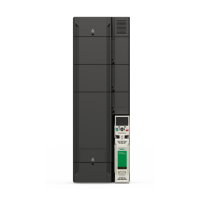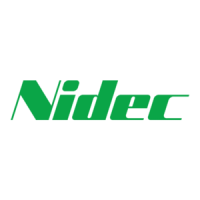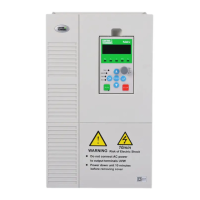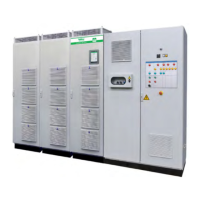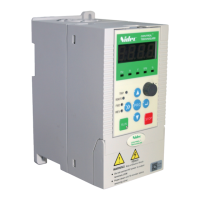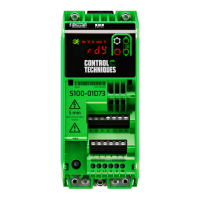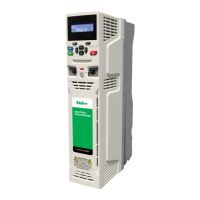
Do you have a question about the Nidec Unidrive M600 Series and is the answer not in the manual?
Covers essential safety, hazards, and installer competence for drive systems.
Details risks associated with electrical shock and burns from drive components and connections.
Warns about lethal voltage present in capacitors after AC supply disconnection.
Discusses hazards related to drive functions, faults, and the need for risk analysis.
Provides instructions for EMC environments and installer responsibility for system compliance.
Explains the use of Regen operation for four-quadrant applications and bi-directional power flow.
Highlights benefits like energy saving, sinusoidal input current, and unity power factor.
Describes how a PWM converter replaces the diode rectifier for bi-directional power flow.
Covers synchronization procedures for Regen drives to the AC supply, including pre-start tests.
Outlines different configurations like single Regen/motoring and multiple Regen/motoring systems.
Illustrates the formation of Unidrive M range model numbers and their identification labels.
Details continuous current ratings, derating factors, and technical specifications for drive models.
Explains the Unidrive M Rectifier as a half controlled SCR/thyristor bridge and its applications.
Lists and describes available option modules, kits, and accessories for Unidrive M drives.
Lists and describes essential Regen filter components such as inductors and capacitors.
Covers factors for sizing a Regen system, including voltage variation and drive ratings.
Details the power connection requirements for various Unidrive M Regen systems.
Explains wiring configurations for SFF capacitors based on drive size and Star/Delta options.
Covers wiring for SFF capacitors supporting high-quality, low harmonic supplies with up to 2% THDv.
Provides guidance on system cable length limits and necessary precautions.
Discusses effects of extended cable lengths and necessary additional components.
Details the arrangement of EMC and SFF filters for Unidrive M Regen input.
Outlines essential safety precautions for mechanical and electrical installation.
Covers critical considerations for planning installations, including access and environmental protection.
Provides dimensions for key Regen system components like inductors and capacitors.
Details AC and DC power connection diagrams for Unidrive M Regen drives across different sizes.
Shows AC and DC power connections for Regen drives, including internal EMC filter removal.
Explains proper grounding arrangements for Regen systems, including stud locations.
Outlines voltage, phase, frequency, and imbalance requirements for the AC supply.
Provides typical input current values and guidance for selecting cables and fuses.
Covers EMC requirements divided into general, power drive system, and industrial environment standards.
Details the use and removal of external EMC filters for compliance with emission standards.
Details setting parameters like switching frequency and DC bus voltage set point for Regen operation.
Explains the step-by-step sequence for enabling the Regen drive and motoring drive.
Provides instructions for powering up and configuring the Regen drive, including parameter settings.
Covers enabling and setting up the motoring drive within a Regen system, including ramp mode.
Explains using power feed-forward to reduce transient DC bus voltage effects.
Discusses the DC bus voltage controller and inner current controllers for system stability.
Guides on optimizing current loop gains, especially proportional gain, for stability.
Details the PI controller for DC bus voltage and its impact on response.
Defines variable ranges and maximums for parameters based on drive rating, mode, and settings.
Provides a quick reference to common setup parameters for easy programming.
Details parameters specific to Regen operation, including voltage and frequency limits.
Covers parameters for controlling active and reactive currents in Regen mode.
Lists parameters for monitoring Regen drive status, output frequency, voltage, and power.
Explains parameters related to drive sequencing, enable logic, and clock functions.
Details the configuration of analog inputs and outputs for voltage, current, and thermistor inputs.
Covers configuration of digital inputs, outputs, relay, and 24V outputs for control functions.
Describes logic functions, motorized pot, binary sum, and timer functions for custom control.
Lists drive status indications, trip codes, sub-trip numbers, and their meanings.
Details parameters for drive identification, serial communications, security, and NV Media Card functions.
Explains threshold detection and variable selection functions for custom logic.
Covers the configuration of PID controllers with programmable reference, feedback, and output limits.
Provides general technical data for the drive, including voltage ratings and power dissipation.
Details maximum permissible continuous output current and drive losses based on switching frequency and ambient temperature.
Outlines voltage, phase, frequency, and imbalance requirements for the AC supply.
Details fuse protection requirements for Regen systems and AC supply fusing.
Lists data for Regen filter components, SFF inductors, capacitors, and EMC filters.
Refers to section 3.9.3 for Switching frequency filter capacitor protection.
Guides on calculating the minimum softstart resistor value for various drive models.
Explains the sizing of thermal/magnetic overload protection for the soft start circuit.
Describes how to interpret drive status via keypad display and LED indicators.
Explains how trip conditions are indicated on the drive display and LED status.
Details how to interpret trip strings and sub-trip numbers to identify the cause of a trip.
Provides a comprehensive list of trips, their sub-trip numbers, and diagnosis.
Lists internal hardware faults that stop all drive functions and require supplier contact.
Explains alarm indications, their meanings, and potential consequences if not addressed.
Details status indications shown on the drive display and option module status.
Lists error messages that may appear on the keypad during drive firmware programming.
Explains how to access and interpret the drive's trip log, including date, time, and sub-trip numbers.
Describes how the drive behaves when a trip occurs and how to diagnose the cause.
Provides the UL file reference number for Unidrive M products and STO function certification.
Details enclosure ratings like Open Type, NEMA Type 12, and their suitability for various environments.
Covers electrical installation requirements including overvoltage category, supply limits, and terminal torque.
